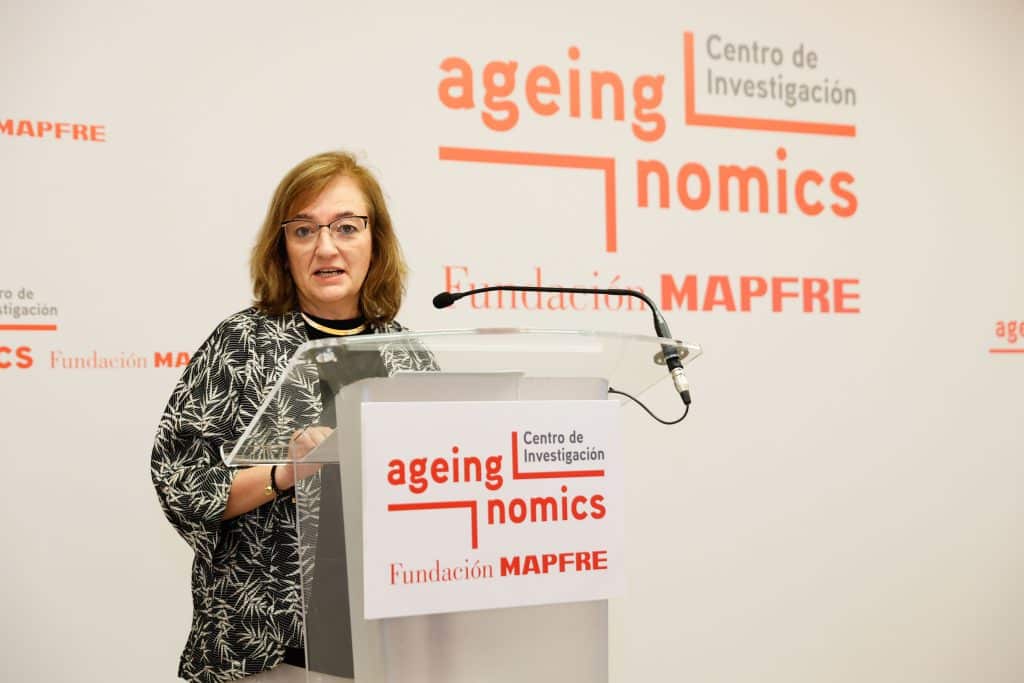
The president of the Independent Authority for Fiscal Responsibility (AIReF), Cristina Herrero, today opened the 2023 Academic Seminar on Pension Systems and Intergenerational Solidarity Mechanisms organised by the Ageingnomics Research Centre of the Mapfre Foundation and the Carlos III University of Madrid. During his speech he pointed out that AIReF seeks to deepen its knowledge and thus be able to provide solutions to a certain phenomenon, ageing, in a well-founded and evidence-based manner. She stated that the aim is to anticipate trends and challenges that require early action and to seek solutions that go beyond short-term visions and deal forcefully with a phenomenon such as the ageing of the population, which is already a reality.
The president explained that AIReF’s vision focuses on the impact of demographics on the sustainability of public finances, but she stressed the need to tackle this challenge in a comprehensive manner because sustainability cannot be fragmented and it makes no sense to place the emphasis on the sustainability of one part without taking into account the implications that this may have on the sustainability of the whole. AIReF will therefore continue to enrich its analyses, for example in terms of intergenerational equity and the adequacy of the pension system.
AIReF has analysed the impact of ageing on the economy and on public finances in its Opinion on the long-term sustainability of General Government published in the first quarter of 2023. This analysis has been carried out from a macroeconomic and budgetary perspective, both on the revenue and expenditure side, over a very long-term horizon. The main conclusion is that the change in the population pyramid, on which there is consensus, affects not only the pension system, but also other expenditure items such as health and long-term care, public revenue and economic growth.
The impact of ageing
Specifically, and despite the positive approach adopted by AIReF (high migratory flow, 7% unemployment rate in 2050 with a higher rate of female participation in employment and of older workers), the decline in the working age population from the 1930s onwards and the consequent increase in the dependency ratio reduce the growth capacity associated with the labour factor. AIReF projects average growth of 1.3% between 2022 and 2070.
Ageing may also lead to changes in the economy’s revenue-raising capacity by altering the composition of income and wealth, as well as consumption patterns. Conceptually the negative effects predominate but the empirical evidence is limited and inconclusive. AIReF maintains historical trends and estimates that resources will increase their weight in GDP from 36% in 2026 to 38.2% in 2050 due to the progressive nature of personal income tax and the measures to increase social security contributions.
In addition, demographic change will have a notable impact on expenditure items such as pensions, health expenditure and long-term care. Specifically, spending on pensions will peak in 2049 at 14.8% of GDP for Social Security pensions and 16.3% including non-contributory and passive pensions. Health care expenditure will increase by 1.3 GDP points between 2026 and 2050, reaching 8.4% of GDP; and long-term care expenditure, currently at 0.9% of GDP, will double by 2050 to 1.7% of GDP.
High cost of inaction
With these projections, as Cristina Herrero argued, AIReF aims to show what could happen to public finances in the future if no action is taken. In fact, the dynamics of revenue and expenditure at constant policies show that inaction or late action would have a very high cost, as debt could reach around 150% of GDP in 2050. On the other hand, if we react now and start to put solutions on the table, the inertial trend in public finances can be reversed. That is why AIReF includes alternative scenarios in its Opinion that allow factors that may have a greater impact on public finances to be identified. For example, three tenths of a percentage point more in long-term growth would reduce pension expenditure by 1.3 points and debt by 29 points, both in 2050, compared with the baseline scenario.
Looking to the future, Cristina Herrero assured that AIReF wants to deepen its analysis at least through two other dimensions: the adequacy of the pension system, which is fundamental for the system itself and for complementary reforms related to savings and their taxation or active ageing; and intergenerational equity. In addition, the Institution will continue to update its long-term forecasts, reviewing its entire demographic scenario, economic assumptions, the impact of reforms and the incorporation of the new dimensions and challenges on the table.
AIReF’s aim with these analyses is none other than to raise awareness of the pressures that lie ahead and the consequent need to articulate a forward-looking national fiscal strategy with the participation of all agents. In 2024 fiscal rules are expected to return and in a few years’ time the pressure of ageing will be felt. According to the president of AIReF, it seems advisable to reach a national agreement that tackles this challenge in a comprehensive manner, making growth and sustainability compatible.






